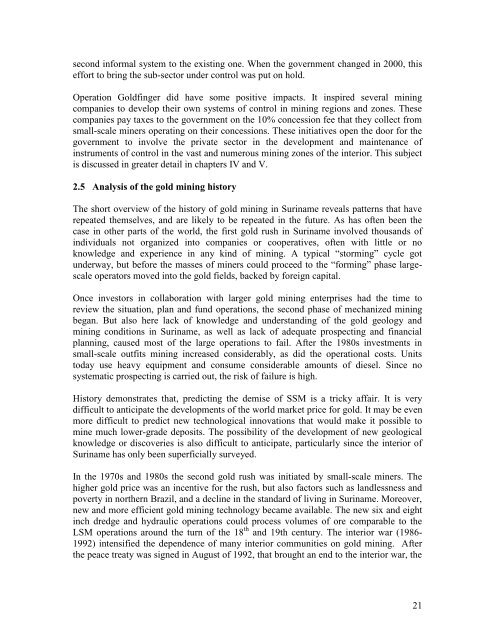SITUATION ANALYSIS OF THE SMALL-SCALE GOLD ... - WWF
SITUATION ANALYSIS OF THE SMALL-SCALE GOLD ... - WWF
SITUATION ANALYSIS OF THE SMALL-SCALE GOLD ... - WWF
You also want an ePaper? Increase the reach of your titles
YUMPU automatically turns print PDFs into web optimized ePapers that Google loves.
second informal system to the existing one. When the government changed in 2000, this<br />
effort to bring the sub-sector under control was put on hold.<br />
Operation Goldfinger did have some positive impacts. It inspired several mining<br />
companies to develop their own systems of control in mining regions and zones. These<br />
companies pay taxes to the government on the 10% concession fee that they collect from<br />
small-scale miners operating on their concessions. These initiatives open the door for the<br />
government to involve the private sector in the development and maintenance of<br />
instruments of control in the vast and numerous mining zones of the interior. This subject<br />
is discussed in greater detail in chapters IV and V.<br />
2.5 Analysis of the gold mining history<br />
The short overview of the history of gold mining in Suriname reveals patterns that have<br />
repeated themselves, and are likely to be repeated in the future. As has often been the<br />
case in other parts of the world, the first gold rush in Suriname involved thousands of<br />
individuals not organized into companies or cooperatives, often with little or no<br />
knowledge and experience in any kind of mining. A typical “storming” cycle got<br />
underway, but before the masses of miners could proceed to the “forming” phase largescale<br />
operators moved into the gold fields, backed by foreign capital.<br />
Once investors in collaboration with larger gold mining enterprises had the time to<br />
review the situation, plan and fund operations, the second phase of mechanized mining<br />
began. But also here lack of knowledge and understanding of the gold geology and<br />
mining conditions in Suriname, as well as lack of adequate prospecting and financial<br />
planning, caused most of the large operations to fail. After the 1980s investments in<br />
small-scale outfits mining increased considerably, as did the operational costs. Units<br />
today use heavy equipment and consume considerable amounts of diesel. Since no<br />
systematic prospecting is carried out, the risk of failure is high.<br />
History demonstrates that, predicting the demise of SSM is a tricky affair. It is very<br />
difficult to anticipate the developments of the world market price for gold. It may be even<br />
more difficult to predict new technological innovations that would make it possible to<br />
mine much lower-grade deposits. The possibility of the development of new geological<br />
knowledge or discoveries is also difficult to anticipate, particularly since the interior of<br />
Suriname has only been superficially surveyed.<br />
In the 1970s and 1980s the second gold rush was initiated by small-scale miners. The<br />
higher gold price was an incentive for the rush, but also factors such as landlessness and<br />
poverty in northern Brazil, and a decline in the standard of living in Suriname. Moreover,<br />
new and more efficient gold mining technology became available. The new six and eight<br />
inch dredge and hydraulic operations could process volumes of ore comparable to the<br />
LSM operations around the turn of the 18 th and 19th century. The interior war (1986-<br />
1992) intensified the dependence of many interior communities on gold mining. After<br />
the peace treaty was signed in August of 1992, that brought an end to the interior war, the<br />
21
















